There’s a quiet revolution happening in software development—one that’s changing how businesses think about building, maintaining, and scaling applications. For years, monolithic architecture was the default: one massive, all-in-one codebase doing everything from user management to payments.
But things have changed.
Today, companies need flexibility, speed, and the ability to adapt without pulling apart an entire system. That’s where composable applications come in.
This shift—from monolithic to modular—is more than a trend. It’s a rethinking of how software should serve business needs.
Why Monolithic Applications Are Becoming a Bottleneck
Monolithic applications aren’t bad by design. In fact, for startups or small teams, they’re often the quickest way to ship a product. But as systems grow, monoliths reveal some serious limitations:
- Tightly coupled components: A change in one module can impact the whole system.
- Slow deployments: Testing and deploying even minor updates becomes complex.
- Scalability issues: You can’t scale one function independently—you have to scale everything.
- Team constraints: Cross-functional teams end up waiting on each other just to make progress.
If you're managing a large system and updates are breaking more than they’re fixing, you're likely facing monolithic pain.
What Are Composable Applications?

Think of composable apps as LEGO blocks for software.
Instead of a single, rigid codebase, you break the application into independent, modular components that can be developed, tested, deployed, and scaled separately.
Each component (often called a "microservice" or “packaged business capability”) handles a specific function—say, authentication, order processing, or billing—and communicates with others through APIs.
These components can be:
- Reused across apps
- Replaced without breaking the whole system
- Scaled independently
- Owned by different teams
This model encourages agility and faster development cycles, especially in cloud-native and hybrid cloud environments.
Key Characteristics of Composable Architecture
A truly composable application exhibits the following characteristics:
|
Feature |
Description |
|
Modularity |
Each part of the system is self-contained and loosely coupled. |
|
Discoverability |
Components are cataloged and easy for teams to find and reuse. |
|
Reusability |
Components can be reused across applications or domains. |
|
Autonomy |
Teams can work independently on different services or modules. |
|
Scalability |
Only the parts that need scaling are scaled, saving infrastructure costs. |
|
Resilience |
Failure in one service doesn’t bring down the entire application. |
Advantages of Moving to Composable Systems
Let’s break down the biggest advantages of modular, composable architecture:
1. Faster Time-to-Market
Instead of waiting for the entire application to be tested and deployed, individual modules can go live independently. This speeds up product updates and innovation.
2. Business Agility
Need to swap out the payments provider? Want to change the UI layer without touching the backend? Composable systems make this easy.
3. Better Collaboration
Cross-functional teams can take ownership of different modules. Developers, designers, and QA can all move in parallel.
4. Improved Maintainability
Bugs and technical debt are easier to isolate. You don’t need to untangle spaghetti code to fix a login issue.
5. Cloud-Native Compatibility
Composable applications fit naturally into containerized, cloud-based environments. They work seamlessly with orchestration tools like Kubernetes and CI/CD pipelines.
Is Composability Right for Every Business?
Not always. Composability brings complexity too.
Here’s a quick comparison:
|
Factor |
Monolithic |
Composable |
|
Startup cost |
Low |
Higher (more setup and governance) |
|
Maintenance over time |
Difficult as app grows |
Easier with proper management |
|
Team size needed |
Small team can handle it |
Needs experienced developers |
|
Flexibility |
Limited |
High |
|
Best for |
MVPs, early-stage products |
Scaling businesses, enterprises |
If your app is simple and evolving slowly, a monolith may still serve you well. But if you're aiming for speed, scale, and adaptability, the case for composability becomes compelling.
Governance and Challenges
With freedom comes responsibility.
Composable systems demand clear API contracts, service ownership, and strong documentation. Without these, you risk building another form of “distributed monolith,” where independent services become tightly coupled all over again.
Common challenges include:
- Increased deployment complexity
- Debugging across services
- Monitoring multiple moving parts
- Ensuring security between APIs
Successful adoption depends on both technical readiness and organizational maturity. It’s not just a dev team initiative—it’s a cultural shift.
Practical Steps to Get Started
If you’re considering the shift to composable architecture, start small:
1. Identify modules that can be isolated
Choose non-critical or low-risk areas (e.g., notifications, analytics).
2. Use API-first design
Ensure services communicate clearly and securely.
3. Set up version control for each service
Avoid dependency issues by keeping releases independent.
4. Create documentation as you go
Make it easy for other teams to use or build on what you create.
5. Establish monitoring early
Visibility is critical when dealing with multiple modules.
Final Thoughts
Composable applications aren’t just a new technical pattern—they’re a mindset shift. One that favors agility, modular thinking, and continuous evolution over the rigidity of old-school software.
Whether you’re building a customer-facing portal, a SaaS product, or internal tooling, embracing modular architecture will help you adapt faster, build smarter, and scale better.
Ready to Modernize Your Architecture?
If your organization is thinking about moving away from legacy systems or monolithic setups, Evermethod Inc. can help you design, build, and manage composable applications that fit your business goals.
Let’s make your software ready for the future—modular, scalable, and truly agile.
Get the latest!
Get actionable strategies to empower your business and market domination
.png?width=882&height=158&name=882x158%20(1).png)

.png/preview.png?t=1721195409615)

%2013.png)


